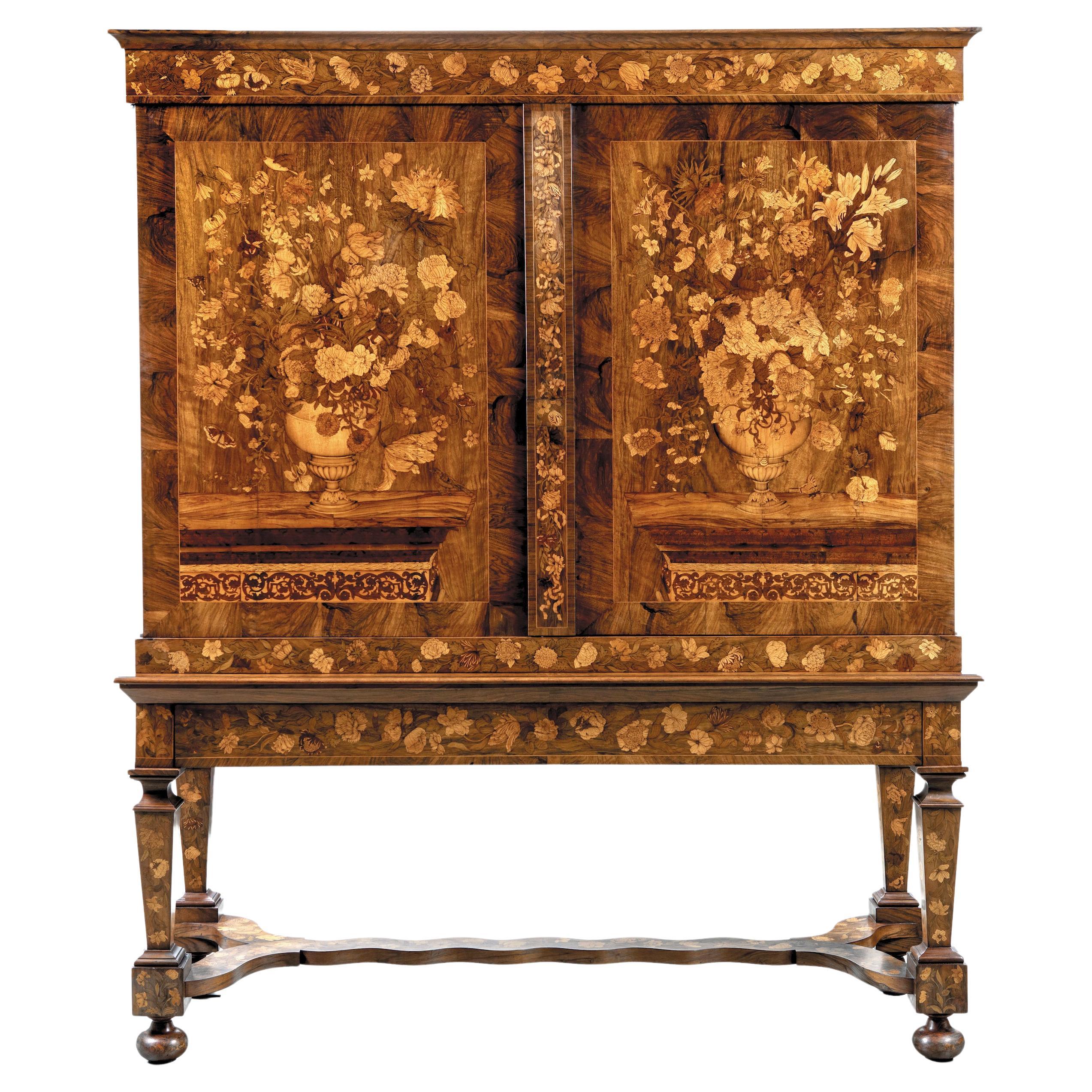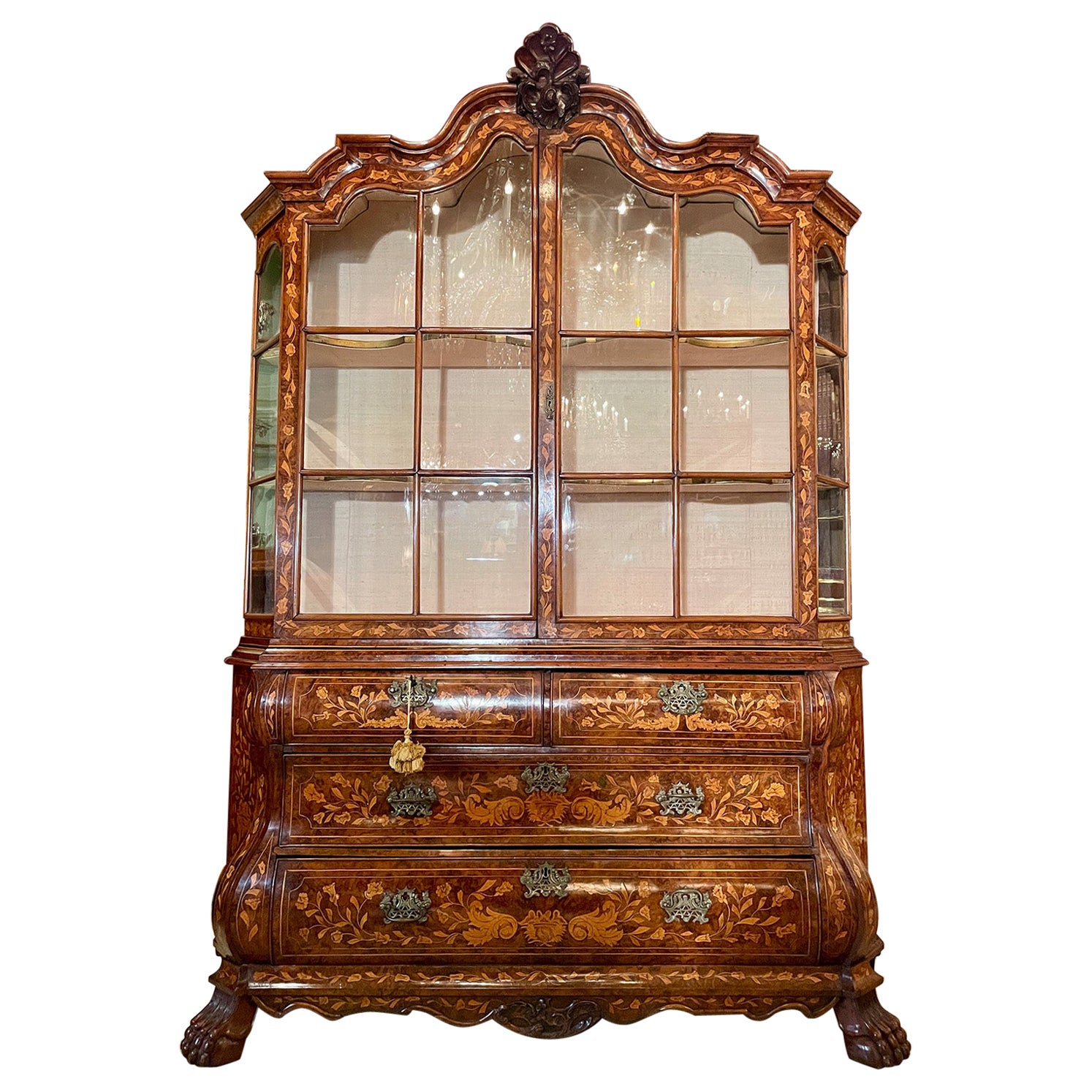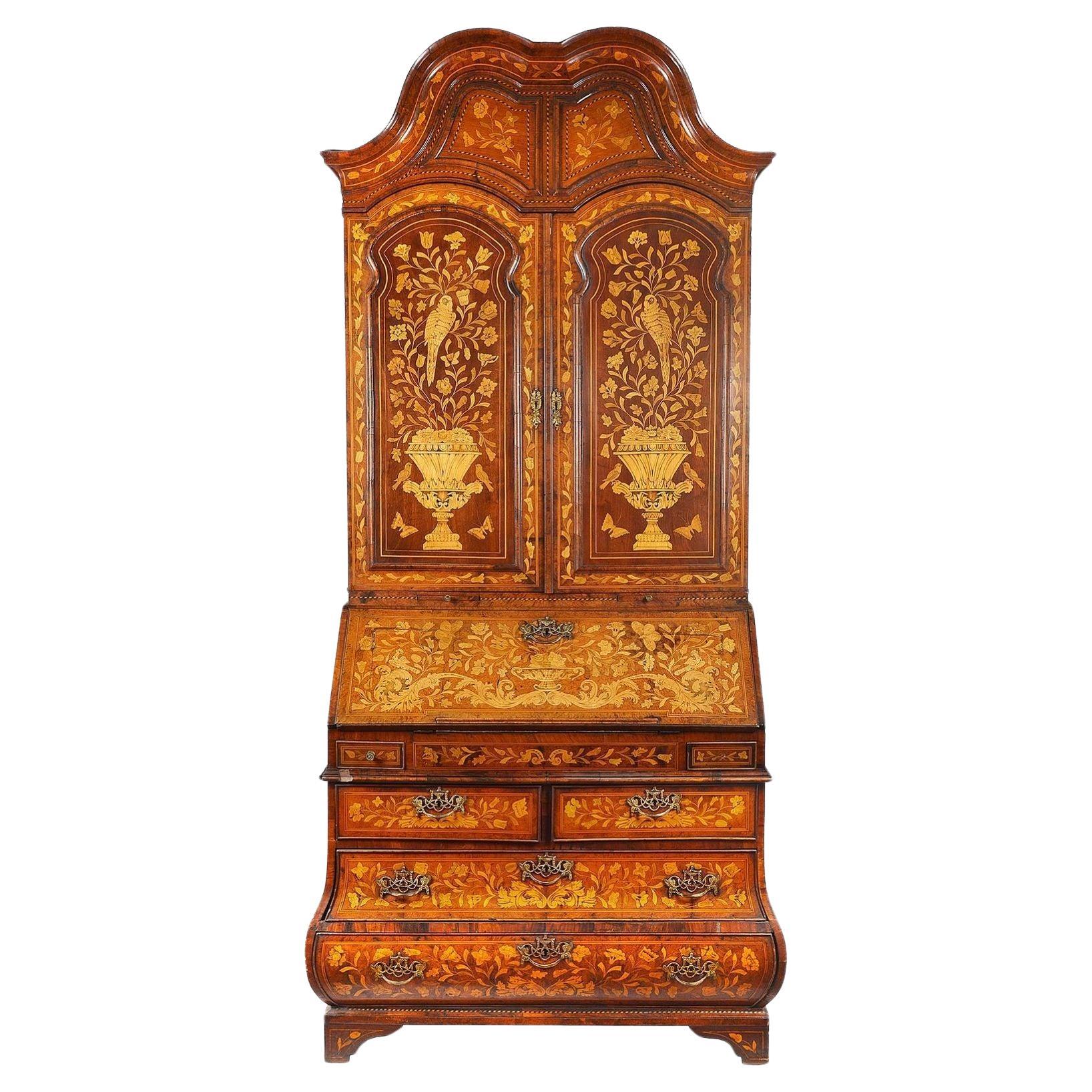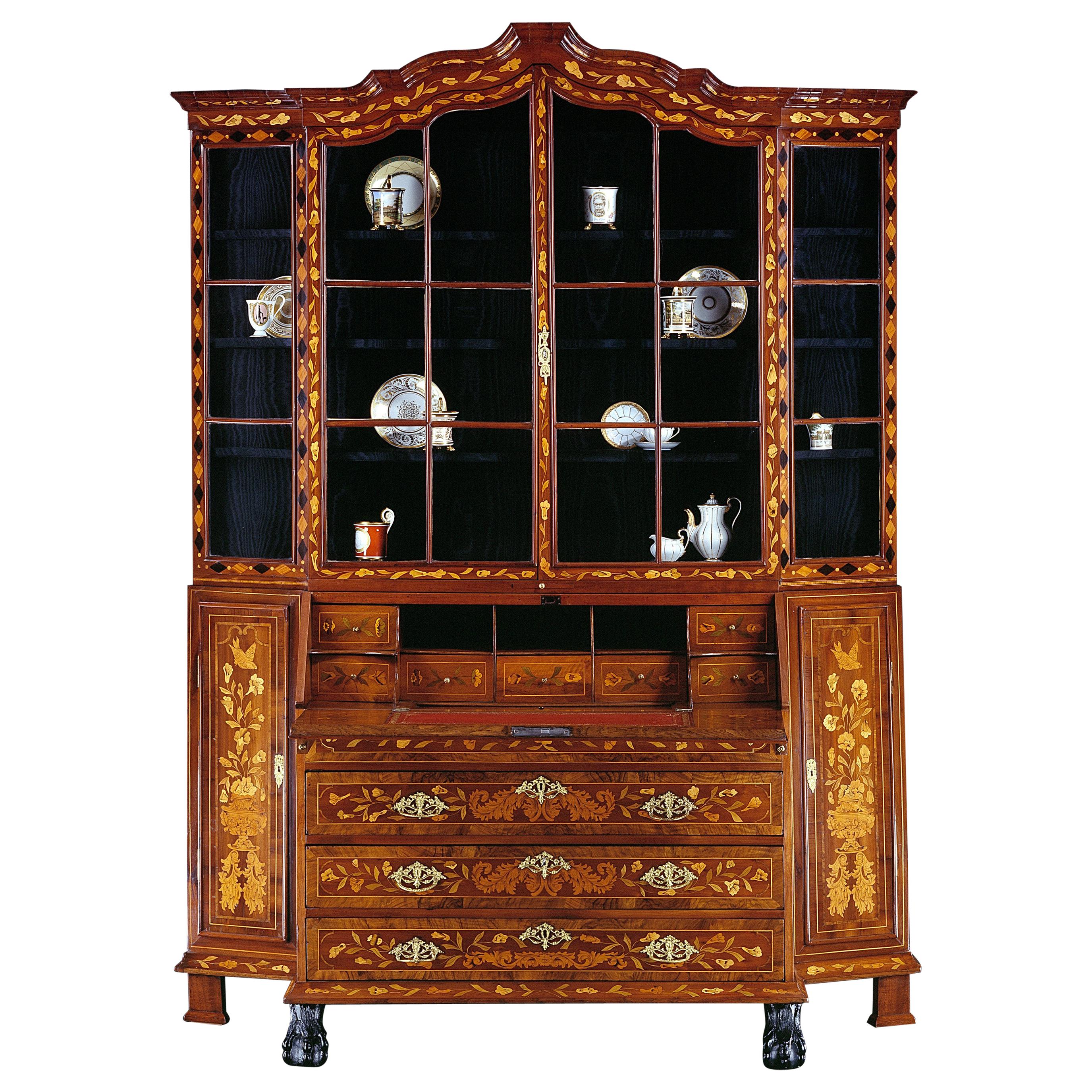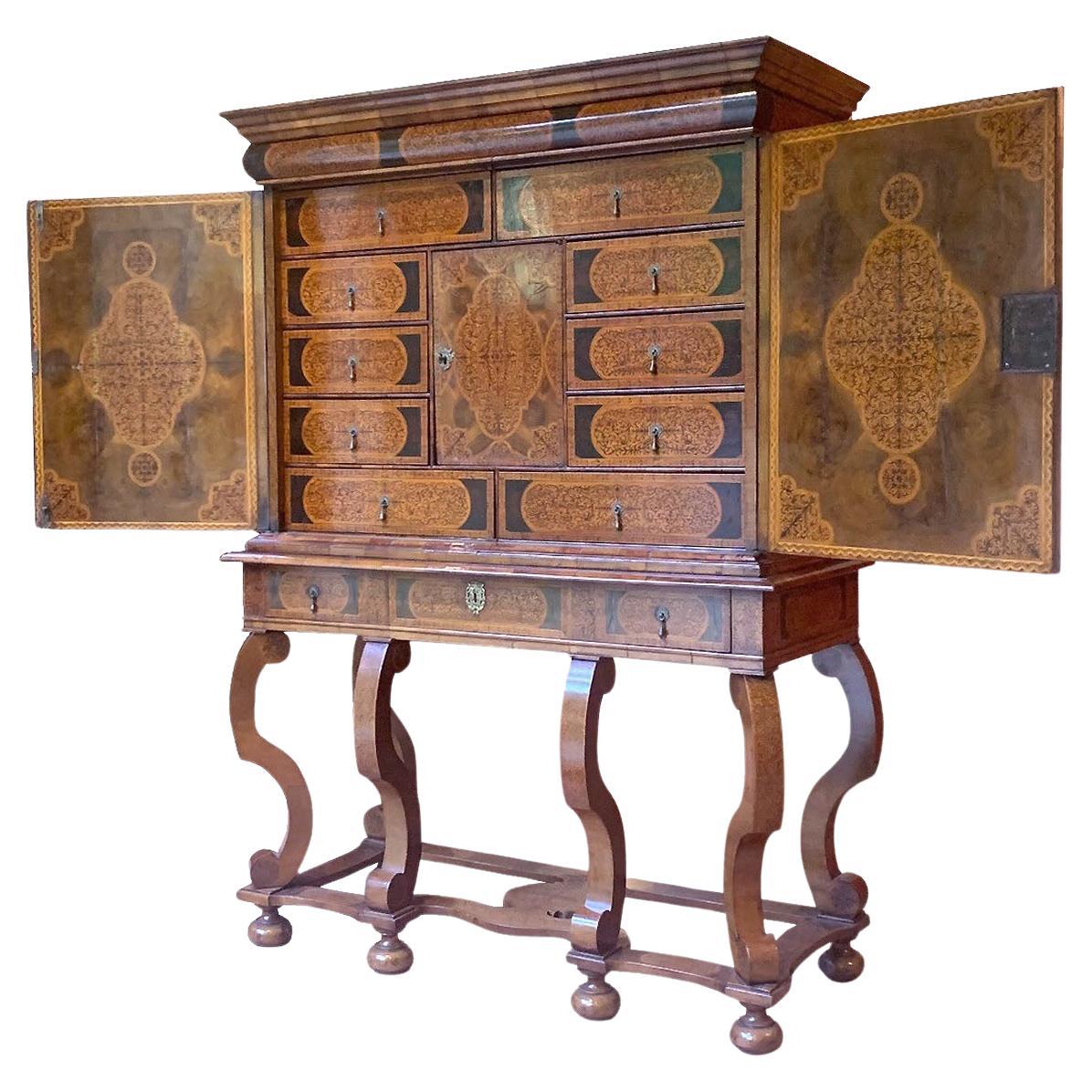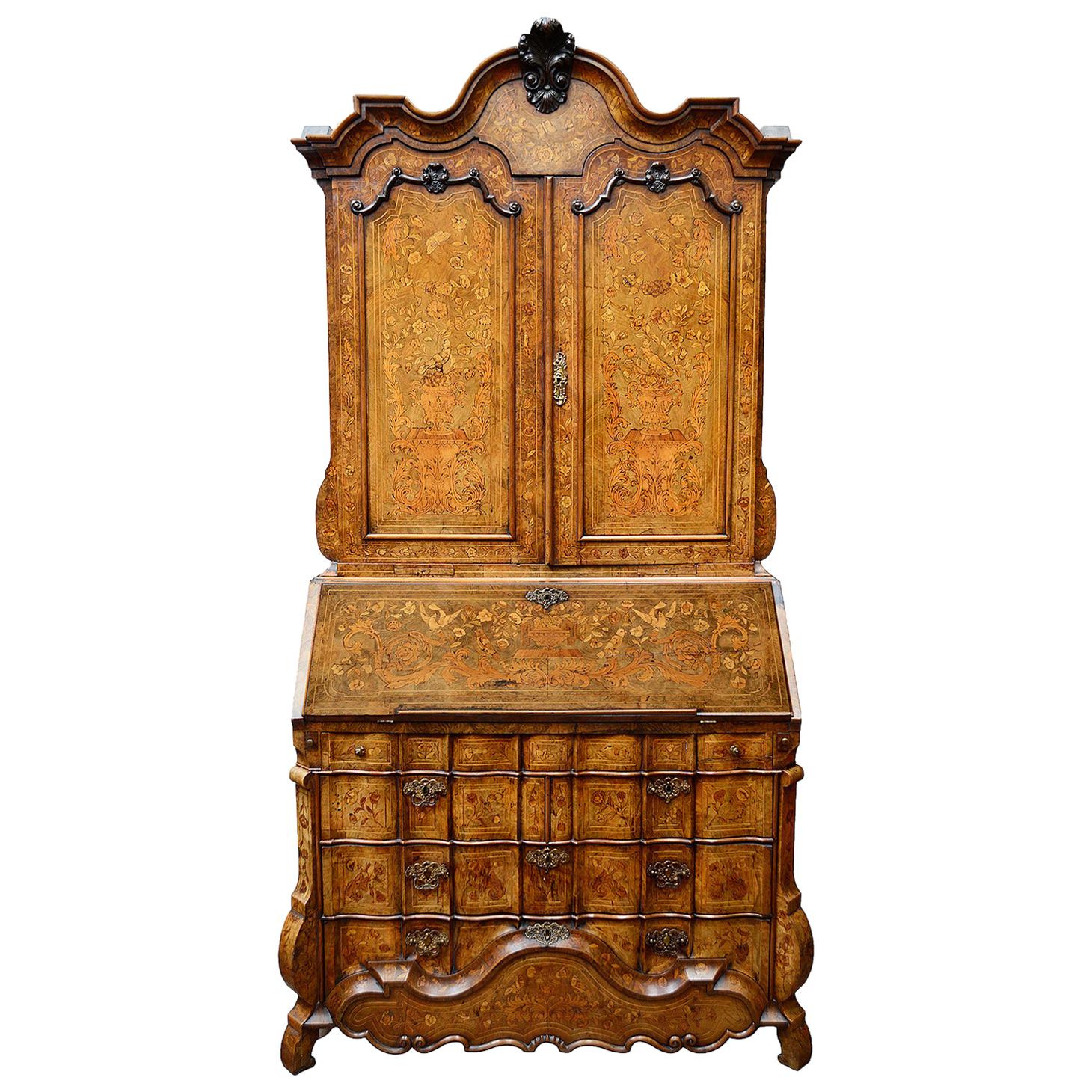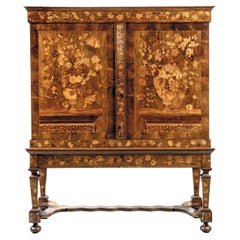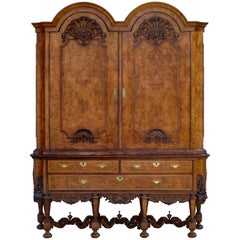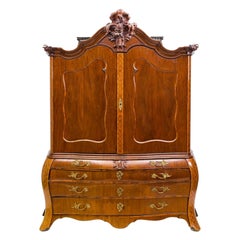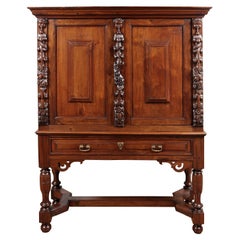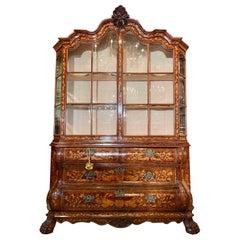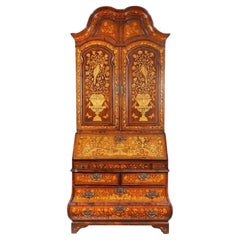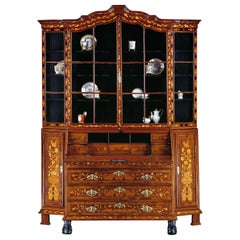Items Similar to A magnificent Dutch marquetry cabinet on stand, by Jan van Mekeren (1658-1733)
Want more images or videos?
Request additional images or videos from the seller
1 of 5
A magnificent Dutch marquetry cabinet on stand, by Jan van Mekeren (1658-1733)
Price Upon Request
Price Upon Request
Price Upon Request
Price Upon Request
Price Upon Request
Price Upon Request
Price Upon Request
Price Upon Request
Price Upon Request
Price Upon Request
Shipping
Retrieving quote...The 1stDibs Promise:
Authenticity Guarantee,
Money-Back Guarantee,
24-Hour Cancellation
About the Item
A magnificent Dutch marquetry cabinet on stand, by Jan van Mekeren (1658-1733) possibly made for William III and Mary of England
Amsterdam, circa 1687
The oak cabinet is decorated with 'arabesque' or 'seaweed' marquetry in Turkish walnut (Juglans regia) on a holly (Ilex aquifolium) font, surrounded by a kingwood (Dalbergia cearensis) border. The top has a modest rectangular cornice of a frieze over two doors revealing the interior fitted with four shelves and five drawers. The inside of the doors and the drawer fronts are veneered with plain cedar (probably Cedrus atlantica). The stand has a frieze drawer and is raised on six S-shaped legs, joined by shaped stretchers and raised on turned ball feet. The entire cabinet, from the cornice to the stretchers, is covered in marquetry.
H. 209 x W. 178 x D. 67 cm
Provenance:
King William & Queen Mary of England or their very close circle, thence by descent (possibly)
Noble collection, England
Literature:
Monique Riccardi-Cubitt, Art of the Cabinet, Thames & Hudson, London, 1992, ill. p. 96 (as English, c. 1695)
The stellar feature of this cabinet is the fine marquetry, which shows scrolling vines, plants, and fruits, clearly recognisable but abstract. The latter’s design was not chosen randomly, for it is filled with symbolism specific to the marriage between William of Orange and Mary Stuart. The letters M and W can be found above each other on each side of the cabinet, with vines and leaves forming a heart in between, praised on each side by a narcissus (a spring flower symbol of new beginnings), placed within a giant thistle. W is in the centre of the cartouche, but M is not. When the M is noticed, one will also see the thistle.
Further, the well-known symbols for the House of Orange, recognisable by many in the Netherlands, have prominent places on the cabinet, such as the Appeltjes van Oranje, which are oranges and their blossom (recognisable because it is the only plant bearing fruit and blossom at the same time); roses for England, olive branches, a symbol of peace and stability (a result of the alliance between England and Holland); thistles (the symbol of the House of - Mary - Stuart, and Scotland); mistletoe, growing in pairs of branches and leaves (stands for being a couple) and is evergreen (for eternity); hazelnuts for fertility; and sunflowers for the transitoriness of/ and kinship.
Today we can’t comprehend that 17th-century people would immediately understand the symbolism. However, sources prove that myths and symbolism were part of education and shared knowledge, at least amongst the literate and educated upper class. With the intricate decoration, a cabinet like this would be a good enough conversation piece for William’s and Mary’s status. After all, a generic one with just a geometric motif was for ordinary people. On the other hand, a cabinet with custom-made iconography would be most entertaining to guests in a candle-lit drawing room. You can imagine a company chatting about the different flowers and their meanings. Another argument for the symbolism being not hidden is a bureau in the Royal Collection Trust, which Gerrit Jensen delivered (in whose studio Van Mekeren worked) in 1690 to William and Mary. The decoration holds the same flora and symbolism as this cabinet, the only difference being a clear monogram with a crown above. The symbolic plants and flowers are just as present on the cabinet, but with a monogram, showing that they were not hidden on both pieces. There is also a gueridon known, not documented, but by repute in the United Kingdom, with the same decoration.
All these symbols, together with the lion and eagles, are seen on the portrait of the young William III by Jan Davidsz de Heem and Jan Vermeer van Utrecht and on an engraving by Pieter van Gunst after Jean Henri Brandon and the designer seems to have used this image for the decoration of this cabinet.
Even more plants with meanings can be identified and combinations intended to be made, which could reveal even more spectator-specific intentions. Unfortunately, much of the meaning of the 17th century and earlier symbols has been lost or has yet to be studied.
Jan van Mekeren had six children with his wife, Maria. He had intended for his first son Fikko, born in 1693, to succeed him as a cabinetmaker, but unfortunately, Fikko died in 1731. After Jan’s death in 1733, the wood trade was continued by his daughter-in-law, but there was no one able to continue his cabinet-making business. Despite a 1624 regulation stipulating members of the Amsterdam cabinetmaker’s guild who offered their wares for sale in the guildís shop, furniture makers in 17th and 18th century Holland hardly marked their work. However, thanks to the inventory after Jan’s death, there is a good list of his workpieces with thorough descriptions, prices, and the names of his clientele.
The estate included many finished and unfinished pieces of furniture, an extensive collection of cabinet woods, and, most interesting, a long list of claims with names of the debtors and the amounts due. Most debtors were well-known Amsterdam patricians.
This cabinet is officially the eighth documented cabinet entirely attributed to, and thus by, Jan van Mekeren. The cabinet’s construction is nearly identical to that of the Van Mekeren Cabinet already in our collection, but also to that of the cabinet in the Rijksmuseum. The construction of the doors is still original and identical to that of the Rijksmuseum. Furthermore, some parts of the marquetry design on the doors and the central marquetry at the front and sides of the frieze are the same as the design on other cabinets by Van Mekeren.
- Creator:Jan van Mekeren (Cabinetmaker)
- Dimensions:Height: 82.29 in (209 cm)Width: 70.08 in (178 cm)Depth: 26.38 in (67 cm)
- Materials and Techniques:
- Place of Origin:
- Period:
- Date of Manufacture:1687
- Condition:Repaired: some veneer losses filled in. Wear consistent with age and use.
- Seller Location:Amsterdam, NL
- Reference Number:1stDibs: LU5458233730122
About the Seller
5.0
Recognized Seller
These prestigious sellers are industry leaders and represent the highest echelon for item quality and design.
Established in 1985
1stDibs seller since 2020
23 sales on 1stDibs
Typical response time: 2 hours
- ShippingRetrieving quote...Shipping from: Amsterdam, Netherlands
- Return Policy
Authenticity Guarantee
In the unlikely event there’s an issue with an item’s authenticity, contact us within 1 year for a full refund. DetailsMoney-Back Guarantee
If your item is not as described, is damaged in transit, or does not arrive, contact us within 7 days for a full refund. Details24-Hour Cancellation
You have a 24-hour grace period in which to reconsider your purchase, with no questions asked.Vetted Professional Sellers
Our world-class sellers must adhere to strict standards for service and quality, maintaining the integrity of our listings.Price-Match Guarantee
If you find that a seller listed the same item for a lower price elsewhere, we’ll match it.Trusted Global Delivery
Our best-in-class carrier network provides specialized shipping options worldwide, including custom delivery.More From This Seller
View AllHighly Important Dutch Floral Marquetry Cabinet by Jan van Mekeren, circa 1700
By Jan van Mekeren
Located in Amsterdam, NL
The Van Mekeren cabinet:
A Newly Discovered Pinnacle by the Master of Marquetry
The highly important Dutch marquetry Van Mekeren cabinet
Amsterdam, circa 1700, by Jan van Mekeren...
Category
Antique Late 17th Century Dutch Cabinets
Materials
Wood, Hardwood, Fruitwood, Kingwood, Nutwood, Oak, Pearwood, Tulipwood
Price Upon Request
Free Shipping
Magificent Dutch 'Daniel Marot' Baroque Walnut Burr Cabinet on Stand, circa 1720
By Daniel Marot
Located in Amsterdam, NL
The Marot cabinet
A Magnificent Walnut Burr Cabinet on stand or 'kruisvoetkabinet' in the style of Daniel Marot
Circa 1720, probably made for George Clifford III in Amsterdam or the Hague
The cabinet is one of the rarest examples of a so-called Kruisvoetkabinet, which is translated to Cabinet on stand. The cabinet is raised on a stand with eight legs and tree drawers. Below the drawers and on the sides are five carved ornaments. The hollow formed corners are mounted with carved ornaments too. The upper part of the cabinet has two doors decorated with panels and on each door two carved ornaments in Marot style. The cabinet has a double dome top.The interior of the cabinet has tree shelves and five drawers. The brass fittings and handles are original and finished with gilt lacquer. The cabinet is made of oak and veneered with burr walnut. The carvings, turned parts and the ball feet are made of solid walnut.
This cabinet is a unique piece of Dutch furniture. Cabinets on stand became popular in the third quarter of the 17th century and were made until the second quarter of the 18th century. Most of the dutch cabinets on stand...
Category
Antique Early 18th Century Dutch Louis XIV Cabinets
Materials
Oak, Walnut
$94,054
Free Shipping
A Superb Dutch 18th-century Rococo cabinet atributted to Matthijs Franses
Located in Amsterdam, NL
Dutch rococo cabinet atributted to Matthijs Franses, in the style of Abraham Roentgen
The Hague, circa 1765
266 high, 193 wide and 70 cm deep
Oak an...
Category
Antique 18th Century Dutch Rococo Cabinets
Materials
Brass
17th Century Dutch-Colonial Indonesian Sono Keeling Foliate Cabinet on Stand
Located in Amsterdam, NL
An Indonesian Sono keeling or Javanese rosewood foliate cabinet on stand or Rankenkast
Jakarta (Batavia), late 17th century
Measures: H 173 x W 133 x D 51 cm
The front of this cabinet is decorated with three carved swags of fruits and flowers coming out of cherub’s heads, a long drawer under two doors and two shelves behind the doors.
Usually, this type cabinet...
Category
Antique Late 17th Century Sri Lankan Dutch Colonial Cabinets
Materials
Rosewood
Rare Dutch Maternity or Child's Cabinet, in Dutch 'Luiermandskast', circa 1650
By Herman Doomer
Located in Amsterdam, NL
A rare Dutch Renaissance 17th-century Maternity room or Child's cabinet, in Dutch called 'Luiermandskast'
circa 1650, possibly the circle of Herman Doomer...
Category
Antique Mid-17th Century Dutch Renaissance Cabinets
Materials
Ebony, Oak
Islamic Indonesian Djati Wood Display Cabinet, circa 1917
Located in Amsterdam, NL
An Indonesian Djati display cabinet
Chinese furniture-makers working in Batavia, late 18th century, dated 1799
Measures: H. 201.5 x W. 120 x D. 53.5 cm
In the middle of the ...
Category
Early 20th Century Indonesian Dutch Colonial Cabinets
Materials
Teak
You May Also Like
Antique Dutch Marquetry Cabinet, Circa 1800-1820
Located in New Orleans, LA
Antique magnificent quality Dutch marquetry cabinet, circa 1800-1820.
Category
Antique 19th Century Dutch Cabinets
Materials
Walnut
18th Century Dutch Marquetry Bureau Bookcase
Located in Brighton, Sussex
A very good quality 18th century Dutch marquetry inlaid bureau bookcase. Having a double dome top cornice, two panel doors, a fall front and bombe shaped base. The wonderfully bold and fine quality inlaid marquetry detail of flowers, birds and vases. The bookcase doors...
Category
Antique 18th Century Dutch Dutch Colonial Desks
Materials
Walnut
Early 19th Century Dutch Floral Marquetry Bureau Display Cabinet
Located in Worpswede / Bremen, DE
The moulded cornice above two shaped glass panelled doors opening to shelves, the lower part with a hinged sloping fall front opening to reveal a fitted interior with a central door ...
Category
Antique 19th Century Dutch Neoclassical Secretaires
Materials
Ormolu
$7,787 Sale Price
51% Off
William & Mary Seaweed Marquetry Inlaid Cabinet by Gerrit Jensen (c. 1634-1715)
By Gerrit Jensen
Located in Rio De Janeiro, BR
This extraordinary cabinet on stand, attributed to the famed English cabinetmaker Gerrit Jensen (active 1667–1715), is a masterpiece of the Baroque period. It epitomizes the luxuriou...
Category
Antique Late 17th Century British William and Mary Cabinets
Materials
Brass
18th Century Dutch Marquetry Bureau Bookcase
Located in Brighton, Sussex
A very imposing good quality 18th century Dutch Marquetry bureau bookcase, having wonderful flowers, birds, classical scull and urn decoration. ...
Category
Antique 18th Century Dutch Desks
Materials
Walnut
A Marquetry and Walnut Prie Dieu, Northern Italy circa 1680
Located in ARMADALE, VIC
A Marquetry and Walnut Prie Dieu, Northern Italy circa 1680
The prie-dieu with canted corners and decorated with walnut and scrolling floral marquetry, the plank top sitting above a...
Category
Antique Late 17th Century Italian Baroque Cabinets
Materials
Hardwood, Walnut
More Ways To Browse
Antique Fruit Stand
New Art Wares
Lion Art By England
Walnut Plant Stand
Folk Art Lion
17th Century Marquetry
17th Century Cabinet On Stand
Dutch Marquetry Cabinet
Netherlands Folk Art
William And Mary Walnut
17th Century Scottish Furniture
17th Century Scottish
Dutch Cabinet On Stand
17th Century Cabinet Dutch
Walnut Veneer Bureau
Antique Cedar Door
Eagle Cabinet
Jans Of London
